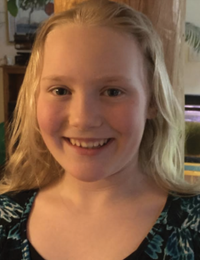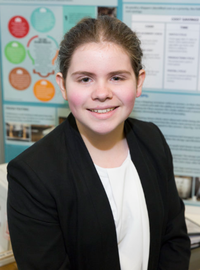
Science fair participant Sam's research found a low positive correlation between homeruns and winning percentages.
Credit: Canadian Science Fair Journal
Peer-review for six-year-olds
Groundbreaking journal unearths new talent.
17 December 2019

Canadian Science Fair Journal
Science fair participant Sam's research found a low positive correlation between homeruns and winning percentages.
A peer-reviewed science journal for school students is giving new life to inventions that might otherwise gather dust under the bed.
The new Canadian Science Fair Journal is the first of its kind, giving school kids as young as six a platform to publish their work, which has so far included creating new bioplastics, forest fire-detectors, and a Dyslexia-friendly reading tool.
Some of the most successful projects are being further developed by professional researchers, with potential to be patented.
According to the team behind the journal, less than 10% of science fair winners in Canada typically publish their findings. The journal, which accepts submissions from students aged 18 and younger, aims to give greater visibility to their projects while connecting students with young scientists through its mentorship and peer-review program.
The students end up with a formal publication and a DOI that they can use to build their professional credit and include in their university applications, says one of the journal’s managing editors, Rhiannon Ng, from the Children’s Hospital of Eastern Ontario Research Institute in Ottawa, Canada.
“One of our biggest goals is to give students a chance to develop their skills early on to become better scientists,” says Ng.
Science writing skills
The Canadian Science Fair Journal has received more than 100 submissions since its launch in 2017, and has so far published two volumes online.
When students submit an article, they are paired with an undergraduate or graduate researcher whose area of study matches their article topic. Together, the student and their editor work to get the article ready for publication. It’s like peer-review, but far more collaborative, says Ng.
“It's more of a mentorship process, because for most of these students, this is their first time publishing a scientific paper and writing up a formal report,” she says.
“Every article that is submitted will ultimately get published, if that student is willing to make the effort to learn about how to properly write a science article.”
For the journal’s Editor-in-Chef, Dayre McNally, a paediatric intensivist at the Children's Hospital of Eastern Ontario and an associate professor at the University of Ottawa (uOttawa) in Canada, it’s a way to address the skills gap experienced by young people in science as they transition from high school to university to graduate studies.
“I've had the opportunity to supervise a couple of dozen trainees [at uOttawa] and what has stood out is, almost regardless of the level of experience, what they struggle with the most is the writing,” says McNally.
“It was this realization that you arrive at grad school or med school, and while you’ve written essays and lots of other types of literature, you haven’t done science writing.”
Designing future tech
The works that have been published so far suggest that the issues students are concerned about are often inspired by personal experiences.
“One of the students is dyslexic, and she did a project on the use of a coloured overlay to help people with dyslexia read,” says Ng. Kalie Bennett's project got the attention of a PhD student studying marine biology, who also has dyslexia.

Kalie Bennett. Credit: Canadian Science Fair Journal
“She was really impressed by the student’s work and got in touch with her and ended up featuring her work in a presentation she gave at a museum,” says Ng.
“The student got a lot out of that one project. She was able to build these connections that she probably wouldn't otherwise have had the opportunity to make, and gained visibility for the disability.”
Ng lists microplastics in waterways, the invention of new bioplastics, and more environmentally friendly fertilizers and pesticides as popular topics among the young authors.
One student, Mac Dykeman, who lives on a farm, decided to investigate better options for transporting chicks when she became aware of the high mortality rate caused by the current boxes. She is now pursuing a patent on the safer box design she came up with for her science fair project.

Mac Dykeman. Credit: Canadian Science Fair Journal
“These students are identifying issues that might seem trivial, but are very real in their local communities,” says Ng.
“They’re trying to find environmentally sustainable solutions to problems that they've identified in their day-to-day lives, which is quite inspiring. There's definitely a sense of urgency there.”
The longevity test
As the team now expands its efforts to running a new video conferencing program alongside the journal, sustaining the current momentum and opening the initiative up to the rest of the world will be a challenge.
While the journal is so far only aimed at Canadian high school students, Ng says international submissions would be accepted on a case-by-case basis.
For Merlin Crossley, deputy vice-chancellor (academic) and professor of molecular biology at UNSW Sydney in Australia, who is not involved in the initiative, the Canadian Science Fair Journal is an important publication, but one which will need to prove its longevity over the long-term.
"What an amazing initiative. Anything we can do to support young people doing science is important,” says Crossley. “But I think it's too early to tell if it will cut through."
Ng says their readership is growing in Europe and Asia, and inquiries have been coming in from teachers in the Philippines and Mexico.
“I think it speaks to how important it is to provide kids everywhere with opportunities to disseminate their science more widely, and the need for organizations and journals that are catered towards those younger students,” she says.
“We joke about our ultimate goal being world domination, but sustainability for the journal is a big thing that we're working on."
